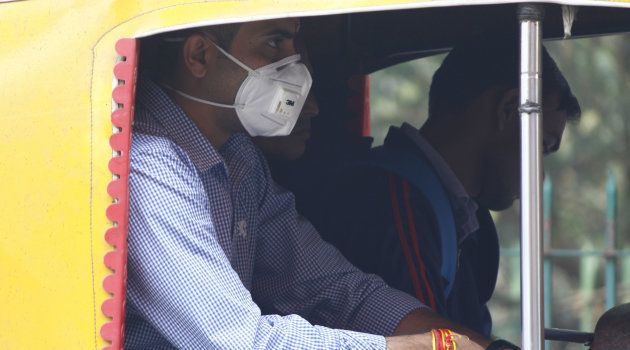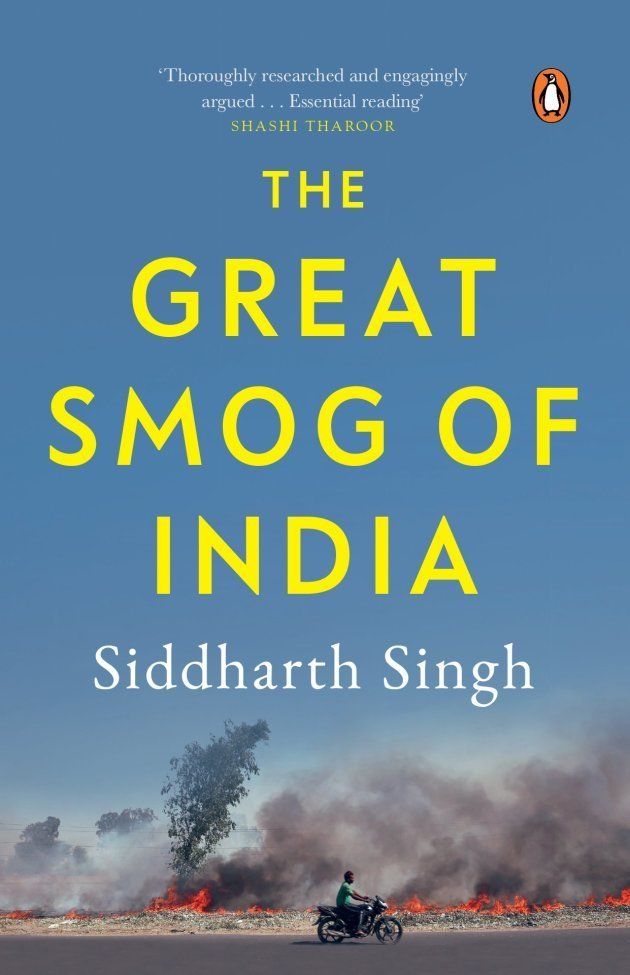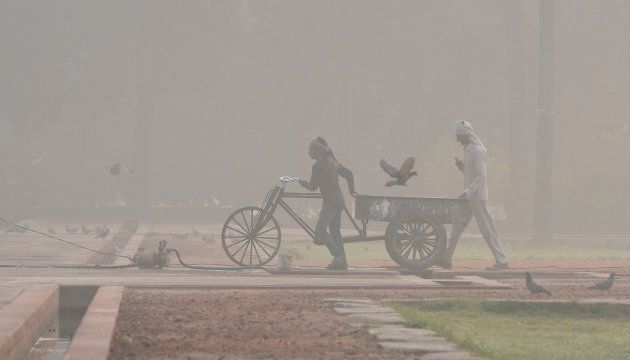
Over the past few years, people in northern India, especially Delhi, have been dreading the winter, which brings with worsening air quality and smog that can cause respiratory problems and other serious health issues. While the government and authorities announce hurried measures every year to tackle the problem, there is not credible long-term measure in place to solve this health emergency.
In his first book The Great Smog of India, which hit the shelves in October, Siddharth Singh claims to speak about the "inconvenient truth" about air pollution, not just in Delhi, but across north India.
The book delves into the many factors—social, economic, political and meteorological—that have brought us to the situation we are in today and why it may be time to panic now.
Singh, an energy, mobility and climate policy expert, writes that while there are several 'knowledge gaps' about air pollution, it cannot stop authorities from searching for a solution. What is more important is that the solutions to the problem have to be national. He compiles several studies and historical events to break down the issue for readers.
Singh spoke to HuffPost India over the phone about the challenges he faced while writing the book, why air pollution is a difficult problem to solve and why the Delhi government can't solve the problem in isolation.
You write at the beginning of the book that you are not an environmentalist. What prompted you to write a book on air pollution?
I was never trained in environmental studies and have not practiced environmentalism professionally. But India's air crisis is so grave, it has made everyone a bit of an environmentalist. Everyone is talking about it and wants to do something about it. The problem, in fact, extends beyond the study of the environment. It manifests itself in many spheres such as energy, transport, industry, construction and agriculture. The book has been my attempt to bring all these different fields together.
What was the research process like?
While the book builds on everything I have learned over the past 7-8 years of working in the field of energy policy, it took me about four or five months of research exclusively into this problem. I particularly benefited from interacting with people from different fields over the years, including meteorologists, climatologists, chemists, physicists, epidemiologists, lawyers and economists. Having access to those kinds of experts professionally gave me a better understanding of the gravity of the problem. As far as reading material goes, I not only looked at scientific studies, books and reports, but also tweets. Some of the foremost experts in the relevant fields are on social media and share their perspectives real time.
Did you discover anything that surprised you while writing this book?
To be honest, even though there were several things that surprised me when I was doing the research, I have now forgotten much of what I initially found surprising. Off the top of my head, one thing that was fascinating to learn was the role of dust in the air pollution problem. We know it exists all around us, but it is still surprising to know that is one of the biggest contributors to air pollution crisis.
What is it about dust in particular that was surprising to you?
Air quality is terrible in India even though we have a much smaller industrial base, lower energy use and lower vehicle ownership than, say, Europe. Then why is it that India has worse air quality? Dust is one of the key reasons. Importantly, the prevalence of dust is not merely a natural phenomenon. It is often made worse by humans. Dust has its origins in the manufacturing industry, such as brick kilns, in improper construction activities, in poorly constructed roads and footpaths, and, importantly, in agricultural activities such as extensive ploughing that leaves the topsoil to become loose.

How do you think dust can be managed?
There are several ways to manage dust. Firstly, we must ensure there is better dust management at industries. Secondly, there should be proper envelopes around construction sites, and we must ensure a clean-up after the construction is over. This almost never happens in India. Thirdly, we have to ensure our roads, our footpaths are properly constructed. We have to ensure all the edges are covered up on both the extreme sides, we don't cover it up and leave it just like that. Also, even today when you drive around Delhi, you see so many patches of land that are neither footpaths nor parks, just land which contains dust. Many parking lots are also unpaved. There is plenty of effort that has to be made at the municipal level. Finally, we need to evolve better agricultural practices to ensure large bowls of dust are not created in the hinterland.
What was the biggest challenge you faced while writing the book?
The biggest challenge was trying to get a proper night's sleep! As far as the book itself is concerned, one challenge that I faced was that much of the information and data that exists are centred around Delhi. There is not enough accessible information out there on say, Lucknow, Punjab, and rural areas in general. We need better monitoring and scientific studies in these regions.
You write about the many measures the governments and authorities have taken and can take. Do you think we are working hard enough to work towards a solution to better air?
We are not working hard enough. The problem is so inter-disciplinary, so inter-agency, so inter-state, there are so many stakeholders involved that it becomes impossible to bring all these people together. To see even a 10% reduction in air pollution, you have to work so very hard and that kind of effort is not happening. We have only been going for the lowest hanging fruits, and even those are being just touched upon and hence we are not seeing the effects. We will need to deepen efforts in all sectors.
You write about how the Delhi half-marathon is conducted during the peak of the 'Great Smog of India' and people still participate. Is there an apathy towards the issue even from urban, educated people or is there a sense of resignation behind this?
One, there is a lack of awareness of what the issue is. My friends who are very well-read and are aware of what is happening around them, even when they read about health consequences of air pollution they get surprised. If well-read people can be surprised by the sheer nature of the problem, the lay person would naturally be much less be aware. A second reason is helplessness. An individual simply cannot have an impact on the air quality around them. If there is filth in a neighbourhood, you can get together with your neighbours and clean it up to see immediate results. What can you do about air pollution?

Do you think the government is doing enough to create awareness around air pollution?
We need far more awareness, the government needs to step up its act. Even if it doesn't want to scare people, they should at least be able to prod people to not contribute to the problem, such as by not burning municipal waste. We are not being taught the importance of not doing this and until people are taught, there won't be change. The government has no incentive to make people panic. But given the grave consequences on health, people should panic.
Since children are among the most affected by air pollution, should part of the solution involve them as well? Will awareness programmes and focus on education help?
Schools are the best place to impart an understanding of this crisis. While basic environmental studies are taught, children don't learn what air pollution does to them in the peak of the smog season. The situation is so grave, children should not be out playing outside. But how do you teach a child this? How do you ask a child not to play outside? These are the kind of challenges our education system faces—how to educate without disheartening the child.
Schools are the best place to impart an understanding of this crisis.
Who does the biggest responsibility lie with—the state government? Or is this an issue impossible to solve in isolation?
The reason this problem is so hard to solve is that there is not one entity to blame, and there is no one entity responsible more than others. It is the key reason why the problem is not being solved. If you speak to a municipal corporation, they will say 'why are you asking us?' If you talk to people at the automotive industry, they will ask you to look at crop fires. If you talk to the farmers in Punjab, they will point at your SUVs. Everyone says 'why should we be the one making those cuts?' All of them are hit in a way.
I think we need some way to bring all of these stakeholders together, which is not happening at the moment. We need institutional responses to air pollution, we need to sit together to evaluate the goals, ask if we have achieved those goals? We need to figure out who is the person involved who did not act, assign responsibility.
How do you think we can bring the stakeholder together?
Firstly, our concept of Swachh Bharat (clean India) should expand to include air and water and not just municipal waste. Secondly—and this is controversial—we need an empowered body to ensure that all these different agencies responsible sit together at least once every few months and work towards the goals. It cannot be left to the lower levels of bureaucracy, but elected leaders at the highest levels have to be a part of this body. Normally I am against creating excessive institutions when we already have many. But in this particular case, the emergency is grave, and the problem is so inter-disciplinary and inter-agency, it will not be solved in isolation.
You have written at length about nuclear power as one of the options for clean energy. This is an opinion quite a few activists would disagree with.
My point is very limited. I don't outright say that nuclear energy is the solution. Nuclear energy comes with its own set of problems, including slow construction and high costs. My point is that every source of energy should be judged with the same yardsticks that nuclear energy is. A study estimated that the use of coal in its various applications contributes to over 150,000 deaths every year in India. Imagine if that happened with nuclear energy. The whole programme would have been shut down if it had even a fraction of the mortality rate. With nuclear energy, we expect all externalities (or negative consequences) to be accounted for. There is no similar expectation from any other source of energy.
Of course, renewable energy such as wind and solar is great. But in the absence of energy storage technology, you will need some form of energy to provide the balancing load of power. This can come from hydropower, but it is proving hard to make new dams due to a variety of reasons. We can use natural gas, but we don't have natural gas in the country, and imported gas is very expensive. Then there is coal and nuclear. We just don't have too many options.
With nuclear energy, we expect all externalities (or negative consequences) to be accounted for. There is no similar expectation from any other source of energy.
Your focus has mainly been Delhi, but there are other cities suffering across northern India. Is the singular focus on Delhi making matters worse, since we know there are smaller cities that are more polluted than Delhi?
The focus is on Delhi because there is much more data and information available for the capital city. There is historical data of how things have evolved. Delhi also has a lot of institutions that have enforced changes, such as the Supreme Court banning crackers and industries in residential areas, the various measures by EPCA, the state government's odd-even scheme and so on. Because so much has happened in Delhi, we can analyse the effectiveness of these measures, and if they can be carried out elsewhere.
But of course, it's not a Delhi problem. The problem of air pollution exists everywhere—from Rajasthan to West Bengal and everywhere in the middle. But if we can understand how a particular measure brought changes in Delhi's air, we can envisage what it would look like in other cities also.

There are several other cities in the world that have been successful to a degree in tackling the problem of air pollution. What are the other cities we can learn from?
Delhi's problem is very unique. We can look at other cities as inspiration but not perhaps as the role model. China cleaned up Beijing's air through a variety of efforts like using natural gas instead of coal for heating, moving industries en mass from the city. A few cities in China have even switched to 100% electric bus fleets and taxi fleets. Such things may be tough to implement in India but we can aim for such aggressive targets.
Los Angeles and Paris focused on public transport to curb air pollution. Is that even possible here?
Even though Delhi's transport system is perhaps better than every other city in India, it is not anywhere close to a point where one can get around as easily as people do in other global cities. Last-mile connectivity is particularly poor. Everyone has been asking people to take public transport, but just imagine what would happen if another million passengers started using public transport from tomorrow. The transport system that exists is already packed to the brim. We need more routes, more options, more buses and metro coaches and better connectivity. People will then naturally gravitate to public transport with the right incentives.